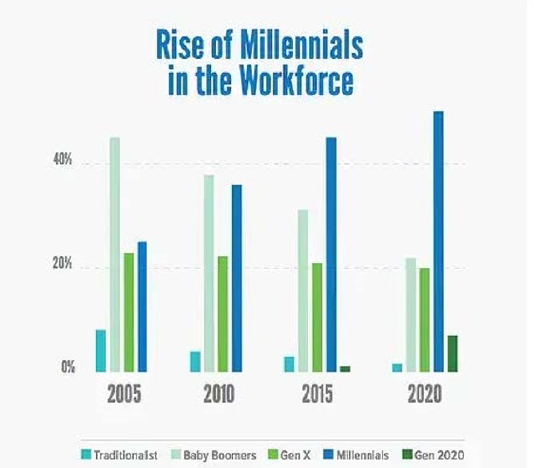If we learned one thing during the last three years of the pandemic, remote work and The Great Resignation, it is that old methods, no matter how tried and true, are not working to attract, hire and retain talent. Circumstances and expectations have changed. More importantly, Millennials and Gen Z employees make up the majority of the workforce around the globe, and both generations are motivated by less-than-traditional factors. So what do employers and their Human Resources departments do to find the quality of employees they need and keep them engaged? It is going to take a little work, some investment in change, and a willingness to meet talent where they are.
Generational Demographics
The chart below shows just how much generational demographics have changed over 15 years. While Millennials represent the largest group by far, you can also see the dramatic decrease in Baby Boomers and the steady supply of Generation X.

While there is some disagreement about age ranges, most research defines the generations as follows
- Traditionalists – born in 1945 and before
- Baby Boomers – born between 1946 and 1964
- Generation X – born between 1965 and 1976
- Millennials – born between 1977 and 1995
- Generation Z – born in 1996 and after
Understanding Generational Differences
Many in senior leadership roles fall in the ranges of Baby Boomers or Gen X. And while there are differences in behaviors and expectations within those groups, the gap from the former to Millennial and Gen Z employees is often wide. Leaders who do not recognize, accept, and address these differences will struggle to attract and retain talent. Let’s take a look at some of the biggest behavioral differences.
- 41% of Millennials say they prefer to communicate electronically rather than face-to-face.
- Millennials check their phones an average of 150 times per day.
- 75% of Millennials seek jobs that have a purpose aligned with their personal values.
- Gen Z will comprise 30% of the workforce by 2025.
- Gen Z is the most racially diverse generation with nearly 50% identifying as non-white.
Understanding Circumstantial Differences
There are several changes in the way younger generations communicate that often create tension between leaders in the workforce and those they lead. They are technology-driven, they are mobile and they do not need an in-person meeting or phone call to feel connected. With the rise of opportunities for remote work and the realization that it is possible to be successful remotely, expectations about having to be in the office have shifted dramatically.
This has made it difficult for employers to keep up and make impactful changes. And some resist the changes because “this is the way it has been done” or “I did it this way, so they should do it this way.” That kind of resistance to change by leaders can be a formula for disaster.
Shifting Your Mindset to Attract a Multi-Generational Workforce
- Invest in people leaders. No matter what generational category workers are in, their direct manager is the tip of the spear for their entire work experience. Invest in training leaders at all levels on ways to lead the workforce of tomorrow.
- Money Matters. Money is a top priority for today’s workers, so do not underestimate the power of competitive pay. Retention is cheaper than onboarding and training a revolving door of new hires.
- Allow flexibility. Remote work is not going away. Working with people to offer more flexibility will attract more employees and reinforce the trust factor that is so important to all employees.
- Increase internal communication Millennials and Gen Z employees communicate electronically in real-time and continuously (texting, tweeting, liking, Facetiming, etc.). This means mobile communication is necessary, so find ways to implement it. Don’t shy away from social media or direct messaging. You can even form private groups for internal news, events and other types of communications as a way to reach more employees.
- Offer a purpose. Millennials and Gen Z employees are seeking purpose. Give them a purpose they can buy into. Know your internal messaging and communicate it clearly and frequently.
If you recognize the need for your organization to become more nimble in attracting, hiring, and retaining the workforce of the future, let’s talk. You can reach me at [email protected].
